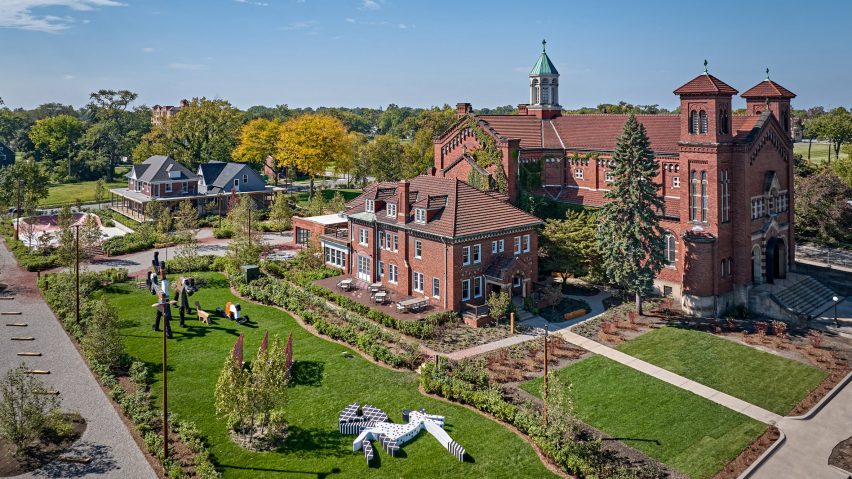Brooklyn architecture studio Peterson Rich Office has adapted an early-1900s Detroit church into The Shepherd arts centre, inserting contemporary art galleries into its nave and transept.
Peterson Rich Office's (PRO) conversion of the original Romanesque-style Good Shepherd Church was based on a desire to keep the "integrity" of its structure intact while creating a performance space, library and two white cube galleries throughout the interior. It is part of the Little Village redevelopment project in the city's East Village.
"PRO's adaptive reuse of the church focused on keeping the integrity of the original architecture intact, while strategically inserting elements into the space to both introduce new programming and to allow for new ways to experience the historic building," said the studio.
The studio removed the "ritual elements of the congregation" from the church's centre and inserted a square gallery unit topped with a mezzanine along the church's nave, which visitors pass through as they enter.
Tucked just in front of this first gallery space, PRO created a brown-painted steel spiral staircase, which leads up to the mezzanine that will host additional programming.
"A new arched-shaped rounded steel staircase rises in front of one of the original stained glass windows," said the studio.
"The stair is clearly contemporary in its materials, construction, and detailing, but has a formal resonance with the existing arches throughout the building."
On the interior of the gallery, an oculus rises through the ceiling to look up at the church's barrel-vaulted ceiling.
This gallery creates a direct view from the church's entrance to the remaining central altar, which was left open for performances and larger installations.
On one arm of the structure's cross, a space was created for the Little Village Arts Library, a branch of the Black Art Library. It houses monographs, exhibition catalogues, children's books and research materials centred around Black artists and movements.
These materials were housed in a long storage unit in front of the church's original wooden confessionals, which PRO repurposed into audio listening booths.
The studio also inserted bookshelves into the confessionals to provide additional space for materials.
Wooden chairs and tables were placed in the area for visitors to use.
Across the East Village Arts Library, in the opposite transept, PRO inserted an additional gallery unit that mirrors the cube form of the gallery placed in the nave. An oculus was also placed at its centre.
Notches were removed from the corners of both galleries that face the church's columns as "a playful gesture toward the existing architecture" said the studio.
PRO also paid homage to the original palette of the church by wrapping the top of galleries in the same brown metal used for the stairs.
"A band of metal wraps around the top of the galleries, continuing the datum line of the surrounding ornate cornicing, similar in material and tone but still reading as something different," said the studio.
Both galleries were finished in a textured plaster.
Warm-toned lighting was integrated throughout the larger church to highlight architectural features, while a cool, even light was used for the interior of the galleries.
The church's exterior was kept largely unchanged, save for the introduction of a "thin, illuminated metal shroud" spanning a central arch as a subtle nod to its new use.
The conversion is part of the wider Little Village development spearheaded by the art institution Library Street Collective, which will encompass several cultural buildings and outdoor areas.
The Shepherd is located on a corner of 3.75 acre (1.5 hectre) Little Village site and will act as an "anchor" for the wider development.
The Shepherd will open in May 2024 along with other projects including the Lantern, a building with spaces for non-profits, artist studios and shops designed by OMA and a permanent sculpture garden dedicated to artist Charles McGee.
The Little Village project also includes a Tony Hawk and McArthur Binion-designed public skatepark, a bed and breakfast designed by local studio Rossetti, culinary arts spaces and a restaurant housed in converted homes by local studio Undecorated and a bar housed in a former garage.
Other projects recently completed in Detroit include a colourful school housed in a former Catholic college and a historic garage converted into a black-box theatre.
Photography is by Jason Keen courtesy of the Library Street Collective
Architect: Peterson Rich Office
PRO project team: Nathan Rich, Miriam Peterson, Amber Farrow, Alex Bodkin, Ben Hochberg, Varoon Kelekar, Martin Carillo, Peik Shelton
General contractor: CIR Group
Local architect: Ark-Tec LLC
Structural engineer: Silman
MEP engineer: Salas O’Brien
Lighting consultant: Andy Watson
Business development consultant: Above The Fold

